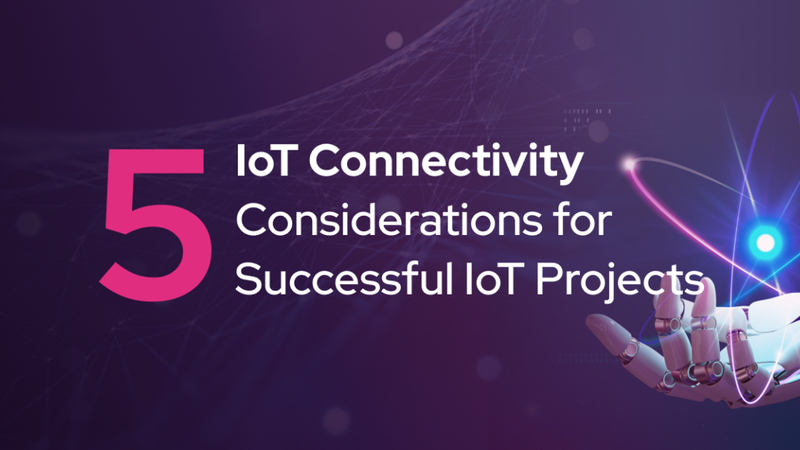5 IoT Connectivity Considerations for Successful IoT Projects
As IoT evolves, projects are shifting from being experimental and exploratory to business critical. This makes them more complex, ensures they receive more scrutiny and, inevitably, increases the opportunities for things to go wrong. This is even more true when you consider that IoT devices and solutions have a long shelf life, making long-term success only possible if you’re properly planning and building today for the unknown factors in the future.

Connectivity is possibly the most important decision you will make. Without the right connectivity, at the best quality and price for your specific requirements, any IoT project is unlikely to ever get beyond the initial planning stages.
5 key IoT connectivity considerations:
1. The location, power, and bandwidth payoff
If you haven’t realized it already, you will soon. IoT projects are all about negotiating requirements and payoffs to find the right balance for your service. Your use case will determine in which location you need your connectivity to function, how long you need your devices’ power supply to last, and whether you need low latency real-time updates, or less frequent, less speedy updates. Combined, this offers a roadmap when making a decision on the type of connectivity you will need.
2. Ease of network deployment
Successful IoT solutions must be integrated with existing technologies and infrastructure rather than attempting to build something entirely new from scratch. There is no value to either the end-user or the business in creating something that is more complex, more expensive and will take longer to deploy. And no one benefits if your IoT applications and devices are operating in a vacuum, “talking” only to each other. The challenge is how to streamline the deployment of devices, and the process for the transfer of data and connectivity to the rest of your operations. Plug-and-play IoT connectivity offers a simple way to do this, reducing both the cost and complexity of any IoT deployment. Legacy OT and IT systems need to be looped in, and your connectivity choice must take this into account.

3. An IoT solution with scale and breadth
An IoT solution is unlikely to be static. Over time, you may add devices, design new applications or take advantage of technology upgrades. Your choice of connectivity needs to be able to scale to adjust to the changing scope of your projects.
This may seem difficult because every IoT service has slightly different requirements, but there is likely to be enough commonality between them to deploy a single connectivity service. To work, two things need to be in place. First, your chosen connectivity service has to scale effortlessly so that newly added endpoints don’t affect overall service levels. Second, your connectivity platform should be built for the broad needs of the IoT industry so that it caters for a variety of applications, sensors, modules, and controllers, as well as varied protocols, networks, and connectivity types.
4. No fuss global coverage
Anyone who has traveled with a mobile phone knows that getting genuinely global data roaming can be hard. For IoT to be truly global, any attempt to DIY global, or even regional or national cellular coverage will add complexity and create additional opportunities for connectivity drops. Instead, bypass setting up, managing and troubleshooting a host of mobile network operator (MNO) relationships by connecting to a single connectivity platform that has already taken care of all this. You get quality of service, faster response times, and integrated connectivity in each location. And don’t forget to look for a user-friendly management platform that offers full visibility of all your IoT applications, wherever they are in the world.
5. Upholding security and data privacy
The wireless portion of an IoT network can be a significant security risk. It needs to be adequately secured and, if managed by others (e.g. MNO), you need complete transparency and visibility to understand to/from where your IoT device is transmitting/receiving data. Without this, you are vulnerable to attacks or data leaks and are offering malicious actors a convenient entry point into your wider enterprise network.
With comprehensive self service functionality you are able to see what is happening, track data, block irrelevant IPs and allow only trusted IPs, and create a VPN to ensure a secure data transfer tunnel between your devices and your cloud platform.
Planning and future proofing will ultimately ensure the success of your next IoT project and connectivity is at the center of this. Find the right IoT connectivity partner and you’ll be on your way to a long-term, scalable and successful project.